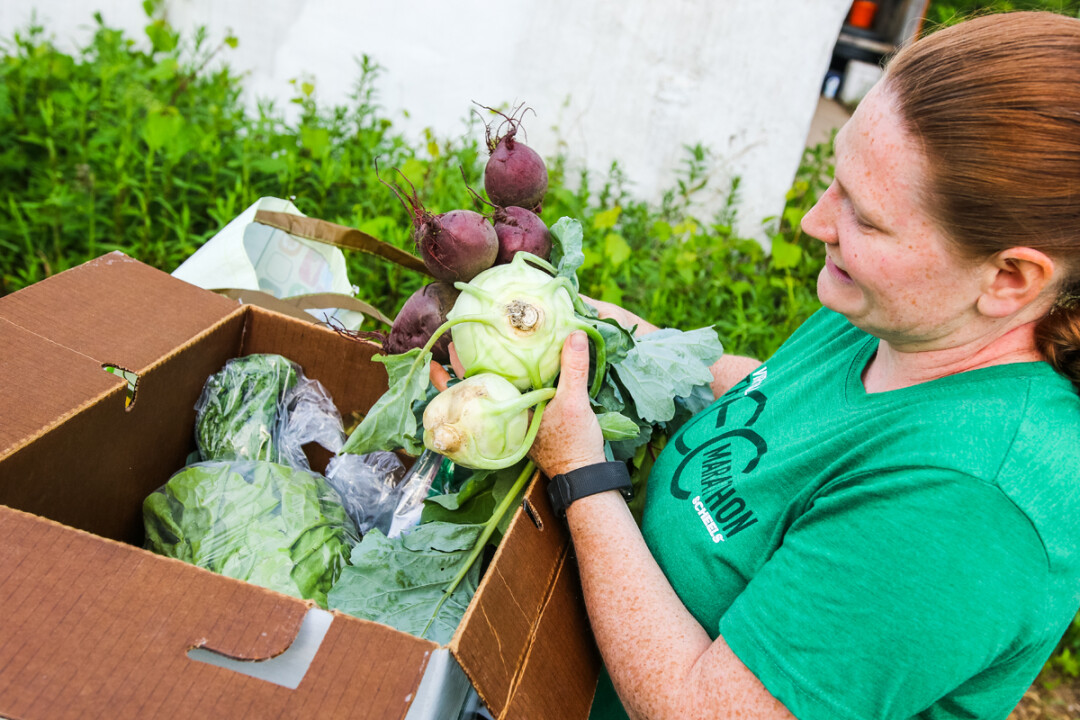Community Supported Agriculture Gets Boost, Thanks to COVID-19
local farmers see an uptick in enrollment for farm-fresh goods
Rebecca Mennecke, photos by Andrea Paulseth

As people across the Chippewa Valley have sought ways to support local farmers during the coronavirus pandemic, community-supported agriculture (CSA) programs have seen a surge in demand.
“I am probably not even close to meeting demand,” said Kristina Beuning, the owner of Sunbow Farm outside Eau Claire. “It’s been absolute insanity.”
I am probably not even close to meeting demand. It's been absolute insanity. –Kristina Beuning, owner of Sunbow Farm
CSA programs allow farmers to sell directly to consumers, eliminating a good portion of food waste and bypassing markets – an advantage during the coronavirus, local farmers say.
The number of shareholders in Sunbow’s CSA program have risen from about 75 to 125 families, with a waiting list of about 50 people, Beuning said.
“People have begun to value local food,” she said.

Square Roots Farm in Fall Creek has seen an increase from 40 to 70 shares in their CSA program since the pandemic hit, according to owner Jake Lau. Despite the increase in demand, Lau said the farm is managing just fine.
Farms have seen a surge in demand for meat as well.
Even before the pandemic, Stephanie Schneider of Together Farms in Mondovi said the farm experienced challenges in supply. The good news, Schneider said, is they implemented more measures to fill some of the demand right before the pandemic hit – meaning “having more (animal) babies,” she said. They are looking to hire a farm production person to try to keep up with demand that has been exacerbated by panic buying of meat.
Together Farms plans for a subscription service to open in September that will allow customers to buy a certain number of pounds of meat per month, with options on various kinds of meats. For now, she said, potential customers can join a waiting list.
Though the rise in demand is good for local farms, the biggest problem for Schneider is a backlog of butchering appointments. They either have to take the animals to the butcher too early or too late.

She suspects this is because of an increase in “panic butchering.” For example, even before the pandemic, her own butcher had an eight-month delay in processing meat. It has been about a year and a half since Schneider has been able to get animals into the butcher, she said.
“The industry went really weird and crazy,” she said.
She said another issue is that butcher prices are skyrocketing. She worries that her customers think she is price gouging, which she said is not the case at all. She is concerned about having too much – or too little – supply, she said.
The industry went really weird and crazy. –Stephanie Schneider of Together Farms
Square Root Farm’s biggest struggle with the pandemic, Lau said, has been seed supply. Square Roots generally sets a plan for crops and seed in early to mid-January, but when the pandemic hit the area in mid-March, others decided they needed that seed, too.
“It’s was really hard to change on the fly,” Lau said.
Luckily, Square Roots had some backup seed, and they planted what was on the schedule nonetheless.
Even the number of picking hours has fluctuated since the start of the pandemic. Beuning said at Sunbow Farm it previously took 60 hours a week of picking to fill demand, but now it takes about 96-160 hours a week. Their goal is to have produce in the consumer’s hands within eight hours of it being picked. “I like to think the demand will continue to stay high,” Beuning said.

She said there is a revitalized focus on supporting local agriculture, and she predicts that will hang around for a while. As for demand, Beuning said with the number of CSA farms in the Chippewa Valley, they can support it. (A complete list of CSA farms is available at the Volume One website).
Beuning recommends that folks looking to join a local CSA program should start looking at supporting a program in November or December. Since farms incur between 50-70% of their costs before the season starts, they need the support earlier in the growing season to cover the costs of seed and such. If you begin looking at CSAs in March or April, Beuning said, you might be too late.

